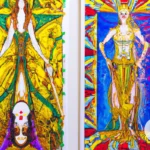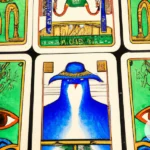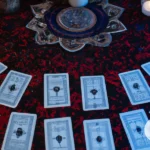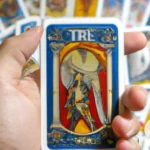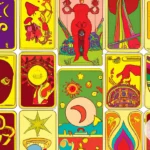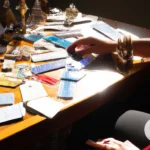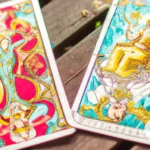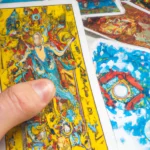The history of tarot cards is shrouded in mystery and intrigue. Despite their use in divination and self-discovery over the centuries, their origins and true purpose remain elusive. However, one thing is certain: the influence of Egyptian symbolism in tarot cannot be denied. From the Sphinx to the Ankh, the rich and iconic imagery of Ancient Egypt has left an indelible mark on the tarot deck. In this article, we delve into the connections between Egyptian culture and tarot history, exploring the emergence of tarot cards and unlocking the significance of their Egyptian influence. Join us on a journey of discovery as we uncover the mysteries of Egyptian tarot.
The Emergence of Tarot Cards
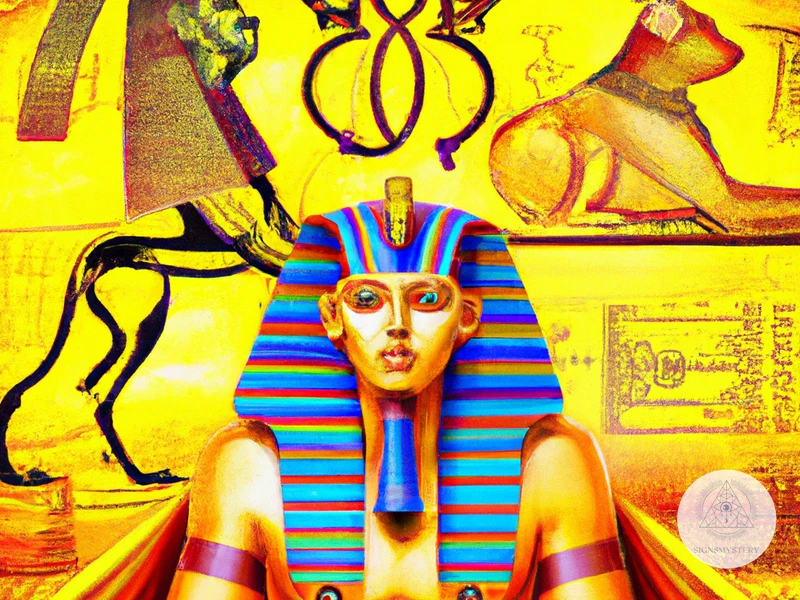
As we delve into the world of Tarot cards, it is hard not to wonder about their origins and how they came to be such a profound tool for divination, healing and self-discovery. The history of Tarot cards dates back to the early 15th century when card games were popular in Italy. However, the true emergence of Tarot cards as we know them today is shrouded in mystery and still a topic of debate among historians and enthusiasts. From the mysterious symbolism of the major and minor arcana to the influence of ancient Egyptian culture, there are a lot of factors that contributed to the evolution of Tarot cards. Let us explore the different aspects of their emergence and how they have evolved overtime with a possible reference to their journey through Europe and the world.
The Early Tarot Cards
The early tarot cards hold a significant place in the history of tarot. These cards were originally known as “triumph cards” and were first introduced in the 15th century in Europe, primarily in Italy. It is interesting to note that the original tarot cards did not have any occult or mystical significance attached to them. In fact, they were used purely for playing card games.
During the Renaissance in Italy, the popularity of tarot cards as a game spread quickly, and various styles emerged. However, it wasn’t until later that the tarot began to be used for divination and spiritual purposes. The symbols on the early tarot cards were often related to Christianity and medieval European culture.
The early tarot deck consisted of only 16 trump cards, and it wasn’t until later that the deck was expanded to include the full 22 cards of the Major Arcana. In the early days, the trump cards were not numbered, and the order in which they appeared differed from deck to deck. The Minor Arcana, which consisted of the four suits (typically swords, wands, pentacles, and cups), was also added later.
It is interesting to note that the early tarot cards did not have any Egyptian symbolism on them, despite the fact that there was a fascination with Egypt during the Renaissance period. It wasn’t until later that the Egyptian connection was made.
The origins of the tarot are shrouded in mystery and there are numerous theories about the true origins of the tarot. Some researchers believe that the tarot has its roots in ancient Egypt, while others suggest that the tarot was influenced by the Jewish Kabbalah, Hermeticism, or other esoteric traditions. Whatever the true origins may be, there is no denying the significant impact that the tarot has had on spirituality and divination.
Anchor: If you want to learn more about the tarot’s mysterious origins and the Major Arcana, check out our article on The Mysterious Origins of the Major Arcana and discover the intriguing history behind these powerful cards.
The Egyptian Connection
The Egyptian influence on Tarot cannot be overlooked. Many scholars argue that Tarot originated in Egypt and was brought to Europe during the Middle Ages. While the exact origins of Tarot cards are still a mystery, it is believed that they were originally created as a form of playing cards in Italy. However, they quickly gained popularity as divination tools, which is possibly due to the strong Egyptian symbolism present in the cards.
Hermeticism and the Tarot
One possible reason for the Egyptian influence on Tarot is the strong connection between Egypt and the Hermetic tradition. Hermeticism is a philosophical and religious tradition that is based on the writings attributed to Hermes Trismegistus, an ancient Egyptian god who was believed to possess knowledge of magic, alchemy, and the occult. This tradition was practiced in Egypt and later in Greece and Rome, and it heavily influenced the development of Western esotericism. Tarot is often seen as a product of this tradition, and this is why we see numerous Egyptian symbols on the cards.
Early Tarot designs and Egyptian Gods
The earliest designs of the Tarot cards are believed to have originated in Italy during the Renaissance. These early designs featured various images of Egyptian gods and goddesses, such as Isis, Osiris, and Horus. These deities were considered to be very powerful, and their images were often used as talismans for protection and good luck. The use of these images in Tarot cards may have been a way of imbuing the cards with their power and energy.
The Major Arcana and The Egyptian Book of the Dead
The Major Arcana, the twenty-two trump cards in the Tarot deck, are considered to be the most powerful cards in the deck. Each card represents a different archetype or aspect of life, and they are often associated with the journey of the Fool. Many of the Major Arcana cards have strong Egyptian symbols, such as the High Priestess, who is associated with Isis and the moon, and the Hanged Man, who is associated with Osiris and the concept of sacrifice. These symbols are believed to be connected to the Egyptian Book of the Dead, which was a funerary text that was used as a guide for the dead to navigate the afterlife.
The Minor Arcana and Egyptian culture
The Minor Arcana, which consists of four suits, each containing ten numbered cards and four court cards, is believed to have been influenced by Egyptian culture as well. The suits correspond to the elements of fire, water, air, and earth, which are also associated with the four sons of Horus, who were protectors of the liver, lungs, intestines and stomach. The numbered cards are also associated with various symbols of Egyptian culture, such as lotus flowers, palm leaves, and ankh crosses.
The impact of Egyptian symbolism on the Tarot
The strong Egyptian influence on Tarot has had a significant impact on the development of the deck as a divination tool. The cards are believed to be imbued with the energy and power of the Egyptian gods and goddesses, and they are often used as a tool for connecting with ancient energies and enhancing spiritual growth. The Tarot has also had a profound impact on spirituality and has been used as a method of divination and self-discovery for centuries.
In the next section, we will explore some of the key Egyptian symbols in the Tarot deck and their significance in divination and spirituality. But before we delve into the symbolism, let’s first take a closer look at the emergence of Tarot cards and their early designs. To learn more about the origins of Tarot and its evolution throughout history, check out our article on Tarot’s Journey Through Europe and the World.
The Major Arcana
The Major Arcana is the first 22 cards in a Tarot deck, which typically represent significant events or archetypes in an individual’s life journey. These cards contain a wealth of symbolism that has Egyptian influences.
One of the most recognizable cards is the High Priestess, which is thought to be connected to the goddess Isis. This card depicts a woman sitting between the pillars of Boaz and Jachin, which were an important symbol in ancient Egyptian architecture. The Emperor card is also believed to have roots in ancient Egypt, with connections to the god Osiris, while the Empress card corresponds to the goddess Nut or Hathor.
The Chariot card is also believed to have strong Egyptian influences. In ancient Egypt, chariots were used for both transportation and warfare, and the chariot in the Tarot represents a sense of control and direction. The Death card, often depicted with the figure of Anubis, is another example of Egyptian influence in the Major Arcana.
It is also thought that the Wheel of Fortune card draws from the Egyptian concept of Ma’at, the goddess who represents balance and order. The image of a wheel is seen in many ancient cultures, representing the cyclical nature of life and the turning of fate.
The Major Arcana cards are rich with Egyptian symbolism and mythological figures, highlighting the deep connection between ancient Egyptian culture and the development of the Tarot. To further understand the roots of Tarot symbolism, it’s important to explore the origins and historical context of Tarot in Renaissance Italy, the influences of Hermeticism and the occult in Tarot, and the impact of Tarot on spirituality in modern times.
The Minor Arcana
The Minor Arcana is composed of 56 cards divided into four suits: Wands, Cups, Swords, and Pentacles. These suits are believed to represent the four elements (fire, water, air, and earth) and the different aspects of human experience.
In the Egyptian Tarot, the Minor Arcana is heavily influenced by Egyptian symbolism. Each suit is associated with a different aspect of Egyptian civilization: Wands relate to the pharaohs and their leadership, Cups to the Nile River and the life it sustains, Swords to the military prowess of ancient Egypt, and Pentacles to the country’s wealth and trade.
Within these suits, each card carries its own unique symbolism. For example, in the Wands suit, the Six of Wands represents victory and triumph, while the King of Wands represents a confident and charismatic leader. The Cups suit, on the other hand, features the Seven of Cups, which offers choices and options, while the Queen of Cups represents emotional depth and intuition.
It’s important to note that the Minor Arcana cards in the Egyptian Tarot are not identical to the traditional Rider-Waite Tarot. Instead, they offer a unique perspective on the meaning and interpretations of these cards.
The influence of Egyptian symbolism on the Minor Arcana cards adds layers of depth and complexity to their meaning. By exploring the history and culture behind each suit and card, we can deepen our understanding of the insights they offer and how they can guide us through life’s challenges. For more information on the origins of Tarot suits and their symbolism, check out the Symbolism of Tarot Suits Origins article. To learn about the occult connections to Tarot, read the article on Tarot’s Occult Connection.
Egyptian Symbolism in Tarot
As we delve deeper into the history of Tarot, we can’t help but notice the strong influence of ancient Egyptian symbolism. Each card of the Tarot deck carries an intricate meaning and is filled with symbolic imagery that has its roots in the Egyptian civilization. These symbols have been carefully handed down through the centuries, and their meaning has remained unchanged. It is fascinating to explore how these ancient Egyptian symbols have found their way into the Tarot deck, and how they enhance its divinatory power. Let’s take a closer look at the Sphinx, the Pyramids, the Hieroglyphs, the Pharaohs, the Gods and Goddesses, the Ankh, and the Scarab, and uncover their secrets within the Tarot deck. As we unravel these mysteries, we begin to develop a better understanding of why Tarot has captured the hearts of so many, leading to its enduring popularity, even in modern times, as evidenced by its significance in France.
The Sphinx
The Sphinx is one of the most recognizable symbols of ancient Egypt and is known for its enigmatic and mysterious nature. Its inclusion in the tarot symbolizes strength, power, and wisdom.
Symbolism: The Sphinx is depicted as a mythical creature with the body of a lion and the head of a human. In the tarot, it represents the idea of riddles and hidden knowledge. The Sphinx is seen as a guardian, and its presence in the tarot suggests that secrets are being protected.
Meaning: The Sphinx is a powerful symbol that represents strength, courage, and the ability to overcome obstacles. Its inclusion in the tarot signifies a need for strength and perseverance.
Interpretation: In a tarot reading, the appearance of the Sphinx can indicate that the querent is on the right path but may need to dig deeper and look beyond the obvious to uncover the truth. It can also suggest that the querent needs to focus on their inner strength to overcome challenges and obstacles.
| Sphinx Symbolism | Sphinx Meaning | Sphinx Interpretation |
|---|---|---|
| Guardian, riddles, hidden knowledge | Strength, courage, perseverance | Need to dig deeper, focus on inner strength, overcome obstacles |
The Sphinx is a powerful and enigmatic symbol that has captured the imagination of people for centuries. Its inclusion in the tarot adds depth and complexity to the reading, urging the querent to explore their inner strength and strive for excellence.
The Pyramids
The Pyramids are one of the most recognizable and awe-inspiring symbols of ancient Egypt. They have been the subject of countless theories and speculations about their purpose, construction, and significance. The Pyramids have also been linked to the history and symbolism of Tarot cards.
One of the most striking aspects of the Pyramids is their enormity and their precise construction. These qualities are often associated with the concept of stability and endurance, which are key elements in the Tarot symbolism. The Pyramid is a symbol of strength, stability, and a connection to the divine.
In the Tarot, the Pyramid is often depicted as a symbol of enlightenment and attainment. It represents the journey to self-discovery and personal growth. The Pyramid is often found in the Major Arcana, which are the trump cards of the Tarot. These cards represent the most significant and profound aspects of the human experience.
The Pyramid is also associated with the concept of balance and harmony. The four sides of the Pyramid represent the four elements of earth, air, fire, and water, which are also key elements in the Tarot symbolism. The Pyramid is also associated with the concept of the triad, which is a common motif in many ancient cultures, including Egypt. The triad represents the spiritual, mental, and physical aspects of the human experience.
The symbolism of the Pyramid in Tarot cards is deeply rooted in the ancient wisdom of Egypt. It represents endurance, strength, enlightenment, and balance. It is a powerful symbol that can help us connect with the divine and unlock our inner potential.
| Symbolism of the Pyramids in Tarot |
|———————————–|
| – Strength and stability |
| – Enlightenment and attainment |
| – Balance and harmony |
| – Association with the elements |
| – Connection to ancient wisdom |
The Hieroglyphs
Hieroglyphs were the writing system used by the ancient Egyptians. They were a combination of pictorial symbols and characters that were used to convey different messages. In Tarot, hieroglyphs are often used to represent different concepts and ideas. Let’s take a closer look at some of the hieroglyphs that are commonly found in Tarot and their meanings.
| Hieroglyph | Meaning |
|---|---|
| Ankh | The ankh is a symbol of life and is often used to represent eternal life or the afterlife in Tarot. It is commonly seen in the hands of gods and goddesses and is also used to represent fertility and regeneration. |
| Eye of Horus | The Eye of Horus is a symbol of protection and is often used in Tarot to represent clarity, vision, and insight. It is also associated with the god Horus and is believed to bring good luck and protect against evil. |
| Anubis | Anubis is the god of embalming and is often depicted as a jackal. In Tarot, he is associated with death and the afterlife. His presence in a reading may indicate the need for transformation or a new beginning. |
| Scarab | The scarab is a symbol of transformation and rebirth. It is often associated with the god Khepri, who was believed to push the sun across the sky each day. In Tarot, the presence of a scarab may indicate the need for change or a new beginning. |
| Animal symbols | The ancient Egyptians believed that animals had certain qualities and characteristics that could be tapped into. In Tarot, animal symbols such as the lion, serpent, and crocodile are often used to represent different traits and qualities. For example, the lion may represent strength and courage while the serpent may represent wisdom and transformation. |
The use of hieroglyphs in Tarot adds a layer of depth and complexity to the readings. Each symbol has its own unique meaning and can help to provide insight and guidance. By understanding the significance of these symbols, readers are able to unlock the mysteries of the ancient Egyptians and connect with their wisdom and energy.
The Pharaohs
Egyptian history is known for its Pharaohs, who were the rulers of ancient Egypt. These powerful and influential leaders are often depicted in tarot as symbols of leadership and authority.
The Pharaohs in Tarot
In tarot, the Pharaohs often appear on cards such as the Emperor, which represents power, control, and authority. The Emperor card typically depicts a Pharaoh-like figure sitting on his throne, dressed in regal attire and holding a scepter or orb, which represents his dominance and power.
The Pharaohs also appear on the Wheel of Fortune card, representing the cyclical nature of life and the power of fate. The card may feature a Pharaoh as a symbol of the cycle of birth, death, and rebirth that was central to ancient Egyptian beliefs.
The Symbolism of the Pharaohs
The Pharaohs were seen as living gods, with great power and authority. In tarot, they symbolize leadership, control, and the ability to rule with an iron fist. The Pharaohs’ association with the gods and goddesses of ancient Egypt also links them to spiritual enlightenment and divine guidance.
The Pharaohs add a sense of grandeur and majesty to tarot cards, bringing to mind the rich history and symbolism of ancient Egypt. They represent power and authority, as well as the cyclical nature of life, making them an integral part of Egyptian tarot symbolism.
The Gods and Goddesses
Using Egyptian gods and goddesses, the tarot deck incorporates symbolism that reflects their qualities and characteristics. The following are examples of some of the gods and goddesses and their representation in tarot:
- Isis: The goddess of magic and nature, Isis is often depicted pouring water from two vases. In tarot, the High Priestess card represents Isis, and is associated with intuition, wisdom and mystery.
- Ma’at: Ma’at is the goddess of truth and justice, and is often represented holding a scale. In tarot, the Justice card represents Ma’at, and signifies balance, fairness and integrity.
- Thoth: The god of wisdom and writing, Thoth is often depicted with a ibis head. In tarot, the Magician card represents Thoth, and symbolizes communication, creativity and skill.
- Anubis: Anubis is the god of funerary rites and guide of souls. In tarot, the Death card represents Anubis, and signifies transformation, rebirth and new beginnings.
- Horus: Horus is the god of the sky and symbolizes protection and royal power. In tarot, the Emperor card represents Horus, and symbolizes strength, leadership and authority.
This deep connection between the gods and goddesses of ancient
Subscribe to Our Newsletter
Sign up to receive the latest news and updates.
The Ankh
One of the most fascinating symbols from ancient Egypt found in the tarot is the Ankh, also known as the key of life or the breath of life. This unique symbol is made up of a cross with a oval loop on the top. The Ankh was believed to symbolize eternal life and was often associated with the goddess Isis. It was also used in various religious and funerary contexts in ancient Egypt.
In the tarot, the Ankh is often used as a symbol of life and vitality. It is also associated with the concept of resurrection and rebirth. When this symbol appears in a tarot reading, it may indicate that the querent is entering a new phase of life or experiencing a spiritual rebirth.
Here is a table summarizing the different interpretations of the Ankh in the tarot:
| Ankh Symbolism in Tarot | Meaning |
|---|---|
| Eternal Life | The Ankh is a symbol of eternal life and may indicate that the querent is on a path towards spiritual enlightenment. |
| Resurrection and Rebirth | The Ankh may symbolize the concept of resurrection and rebirth. It may indicate that the querent is entering a new phase of life or experiencing a spiritual transformation. |
| Strength and Vitality | The Ankh is often used as a symbol of strength and vitality. It may indicate that the querent has the energy and power to overcome challenges and obstacles. |
The Ankh is a powerful and mystical symbol that has been used for centuries in tarot readings to unlock the mysteries of life and the universe. Its intricate design and deep symbolism have captivated the imagination of countless people throughout history and continue to fascinate and inspire tarot readers and enthusiasts today.
The Scarab
The Scarab is one of the most significant symbols in the Egyptian Tarot deck and has a deep-rooted meaning in Egyptian culture. It is a representation of the sacred beetle, which was believed to be a manifestation of the sun god Ra. This symbol is also associated with the concept of rebirth and regeneration, as the Scarab beetle is known for rolling its dung into a ball and burying it, only for new life to emerge from it.
In the context of Tarot, the Scarab symbolizes renewal, transformation and the ability to overcome obstacles. Its appearance in a reading signifies that the seeker is going through a period of transition and that positive changes will come from their current situation.
The Scarab is often depicted in Egyptian Tarot as a beetle with its wings outstretched and holding a solar disk between its legs. The scarab is also surrounded by other symbolic elements, such as the Ankh, the Eye of Horus, and the Lotus Flower. Each of these elements adds additional layers of meaning to the Scarab symbol.
Symbol Meaning
Solar Disk: Represents the sun god Ra and his life-giving energy.
Wings: Symbolize the ability to rise above obstacles and gain a new perspective.
Ankh: A symbol of eternal life, which represents the connection between the physical and spiritual realms.
Eye of Horus: Signifies protection, healing, and restoration.
Lotus Flower: Represents purity, enlightenment, and rebirth.
The Scarab symbol in Egyptian Tarot is a powerful reminder of the cyclical nature of life and the potential for growth and transformation. Its presence in a reading encourages us to embrace change and trust in the natural process of evolution.
The Significance of Egyptian Tarot
As we delve deeper into the history of Tarot cards, it becomes evident that the influence of Ancient Egypt cannot be ignored. With its rich symbolism and mystical allure, Egyptian tarot continues to captivate and intrigue seekers of spiritual insight. But what is the significance of this unique style of tarot? What secrets does it hold, waiting to be unlocked by those with a keen eye and an open mind? In this section, we will explore the profound impact that Egyptian tarot can have on our spiritual growth and understanding. Let us journey on, and see what mysteries await us in the world of Egyptian tarot.
Unlocking the Mysteries
Egyptian Tarot is a powerful tool for unlocking the mysteries of the universe. Each card in the deck features intricate Egyptian symbolism that serves as a doorway to deeper insights and understanding. By exploring the meanings and messages of these symbols, one can gain a greater understanding of themselves and the world around them.
When we use Egyptian Tarot for divination, we are essentially tapping into the collective knowledge of ancient Egyptian culture. The symbols and archetypes depicted in the cards have been used for centuries to convey deep, universal truths about the human experience. Through the process of divination, we can access this knowledge and gain insights into our own personal situations and questions.
However, the mysteries that can be unlocked through Egyptian Tarot go far beyond simple divination. By contemplating the meanings of the symbols and archetypes, we can gain a deeper understanding of the fundamental underpinnings of reality. We can gain insights into the interconnectedness of all things and the hidden forces that shape our lives.
By using Egyptian Tarot for meditation and contemplation, we can tap into these deeper levels of understanding. As we contemplate the symbols and their meanings, we open ourselves up to new insights and realizations. We can connect with the ancient wisdom of Egypt and the universal truths that lie at the heart of all spiritual knowledge.
Ultimately, unlocking the mysteries of Egyptian Tarot requires a willingness to explore and engage with the symbols at a deep level. It requires an openness to new ideas and perspectives and a willingness to let go of preconceived notions and limiting beliefs. Through diligent study and practice, one can develop a deep and profound relationship with this powerful tool for self-discovery and spiritual growth.
Developing Intuition
One of the key benefits of using Egyptian Tarot cards is the ability to develop and enhance your intuition. When using these cards, you’re encouraged to tap into your inner wisdom and listen to your intuition. Through practice and continued use of the cards, you can become more skilled at interpreting their meanings and using them to guide your decisions.
| Benefits of Developing Intuition with Egyptian Tarot: |
| 1. Increased Self-Awareness: |
| By regularly using the cards, you may begin to notice patterns in your thoughts, beliefs, and behaviors. This increased self-awareness can help you make positive changes in your life and grow as a person. |
| 2. Enhanced Decision Making: |
| Trusting your intuition can lead to more confident and effective decision making. When faced with tough decisions, you can use the guidance from the cards to help make choices that align with your values and goals. |
| 3. Improved Spiritual Connection: |
| Working with Egyptian Tarot can help you connect with your spirituality and higher self. By tuning into your intuition and inner guidance, you can deepen your connection to the divine and gain a greater sense of purpose and meaning in life. |
| 4. Heightened Creativity: |
| The symbolism and imagery in Egyptian Tarot can spark your creativity and inspire you to think outside the box. By using your intuition to interpret the cards, you can tap into your creative potential and approach challenges with fresh perspectives. |
Developing your intuition with Egyptian Tarot can lead to a greater sense of clarity, confidence, and fulfillment in all areas of your life. It’s a powerful tool for personal growth and spiritual development, and can help you uncover the mysteries of your own mind and soul.
Connecting with Ancient Energies
Connecting with Ancient Energies
One of the most exciting aspects of using Egyptian Tarot is the opportunity to connect with the ancient energies of Egypt. The symbols, images, and colors used in Egyptian Tarot have a unique vibrational frequency that can be felt intuitively. By interpreting these symbols, we can gain insight into ancient wisdom and connect with the energies of the gods and goddesses of Egypt.
Egyptian Tarot as a Path of Spiritual Advancement
Egyptian Tarot can be an excellent tool for spiritual growth and self-discovery. By meditating on the images, we can tap into the deep wisdom and knowledge of the ancient Egyptians. Each card represents an archetype, a universal pattern of human experience that has been present throughout history. By understanding these archetypes, we can gain a deeper understanding of ourselves and our place in the world.
Using Egyptian Tarot to Connect with Your Inner Self
The images of the gods and goddesses in Egyptian Tarot can also be used as focal points for meditation. By focusing on a particular figure, we can align ourselves with their energy and qualities. For example, meditating on the Goddess Isis can help us connect with our intuition and inner wisdom. The God Anubis can help us confront our fears and anxieties, and the Goddess Ma’at can help us find balance and harmony in our lives.
Connecting with the Divine Feminine
Egyptian Tarot is also an excellent tool for connecting with the divine feminine. Throughout the tarot, we see images of powerful and wise goddesses such as Isis, Ma’at, and Hathor. By meditating on these images, we can cultivate a deeper connection with our own feminine energy and with the sacred feminine energy of the universe.
| Benefits of Connecting with Ancient Energies through Egyptian Tarot | Ways to Connect with Ancient Energies through Egyptian Tarot |
|---|---|
| Increased sense of clarity and purpose | Study the mythology and history of ancient Egypt |
| Greater intuition and insight | Use the images as focal points for meditation |
| Deeper connection with the divine feminine | Explore the goddess archetypes present in the tarot |
| Enhanced spiritual growth | Reflect on the messages of the cards and how they apply to your life |
Connecting with the ancient energies of Egypt through Egyptian Tarot can be a deeply transformative and enlightening experience. By exploring these archetypes and symbols, we can gain insight, deepen our intuition, and connect with the divine feminine. Using Egyptian Tarot as a tool for spiritual growth and self-discovery can lead to a greater sense of purpose and fulfillment in our lives.
Enhancing Spiritual Growth
One of the most significant aspects of using Egyptian Tarot cards is the potential for enhancing spiritual growth. By connecting with the ancient symbols and energies embodied in the cards, practitioners can gain insight and wisdom about themselves and the world around them.
Self-Discovery: Many of the images and archetypes present in Egyptian Tarot cards can serve as mirrors for the individual’s psyche. Through introspection and contemplation, one can gain a better understanding of their own inner landscape and the forces that shape it.
Expanded Consciousness: The Egyptian civilization was known for its profound understanding of spiritual and metaphysical principles. By working with the symbols present in the Tarot deck, practitioners may be able to tap into these higher levels of consciousness and gain a deeper understanding of the nature of reality.
Connection to Higher Powers: Egyptian Tarot cards are often seen as a tool for connecting with the divine. Whether through meditation, prayer, or other spiritual practices, practitioners may be able to access the wisdom and guidance of the gods and goddesses depicted in the cards.
Clarity and Insight: By using the cards to focus their intuition and inner wisdom, practitioners may be able to gain a clearer understanding of the challenges and opportunities present in their lives. Through this process of divination, they may be able to gain insight into the path ahead and the choices that will lead them to their highest potential.
Spiritual Growth: The use of Egyptian Tarot cards has the potential to facilitate significant spiritual growth and development. By working with these ancient symbols, practitioners can tap into the timeless wisdom of the Egyptian civilization and gain profound insights into themselves and the world around them.
Conclusion
In conclusion, the influence of Ancient Egypt on the history and symbolism of tarot cards cannot be overstated. The connection between the two is undeniable and has been acknowledged by tarot historians and scholars worldwide. Through the intricate and nuanced depictions of Egyptian gods, goddesses, and ancient symbols, tarot cards provide insight and guidance on a spiritual, emotional, and intellectual level.
The use of Egyptian symbolism in tarot cards has contributed to their enduring popularity and significance in contemporary society. The rich and captivating imagery of pyramids, hieroglyphs, and pharaohs allows individuals to connect with the mysteries and energies of an ancient time, providing a unique perspective on the human experience.
Moreover, the use of Egyptian tarot has helped individuals unlock the mysteries of their own lives, develop their intuition, and connect with spiritual energies unique to their personal journey. By embracing the symbolism and meanings of Egyptian tarot, an individual can achieve new levels of spiritual growth and enhance their personal understanding of the world and themselves.
In summary, the significance of Egyptian tarot is vast and varied, providing individuals with an opportunity to connect with ancient wisdom and understand the complexities of the human experience. By delving into the rich history and symbolism of tarot cards, one can uncover new insights and unlock the mysteries of the cosmos.
Frequently Asked Questions
What is the origin of tarot cards?
The origin of tarot cards is unclear but it is believed that they were originally used as playing cards in Italy in the 14th century.
What is the connection between Egypt and tarot cards?
There is evidence that the imagery and symbolism of tarot cards were heavily influenced by ancient Egyptian beliefs and culture.
What are the Major Arcana cards in the tarot deck?
The Major Arcana cards represent major life events and spiritual themes, such as The Fool, The Magician, and The Lovers.
What are the Minor Arcana cards in the tarot deck?
The Minor Arcana cards represent everyday events and situations and are divided into four suits: Swords, Wands, Cups, and Pentacles.
What is the Sphinx symbol in tarot cards?
The Sphinx represents power, wisdom, and mystery, and is often associated with riddles and puzzles.
What is the significance of the pyramids in tarot cards?
The pyramids represent the ancient wisdom and timeless knowledge of the Egyptian civilization, as well as the concept of eternal life.
What is the meaning of the hieroglyphs in tarot cards?
The hieroglyphs represent the written language of the ancient Egyptians, and are often used to convey hidden or esoteric messages in tarot cards.
What is the significance of the pharaohs in tarot cards?
The pharaohs symbolize power, leadership, and authority, and are often used to represent the idea of following one’s own unique path in life.
What are the gods and goddesses in tarot cards?
The gods and goddesses represent different aspects of the divine, and are often associated with specific themes or areas of life, such as creativity, love, or abundance.
What is the meaning of the ankh symbol in tarot cards?
The ankh represents eternal life and spiritual rebirth, and is often associated with the concept of immortality.



